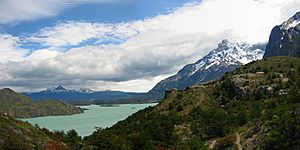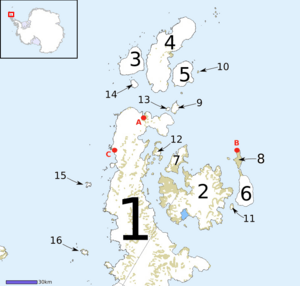Otto Nordenskjöld facts for kids
Quick facts for kids
Otto Nordenskjöld
|
|
|---|---|

Otto Nordenskjöld
|
|
| Born | 6 December 1869 Hässleby, Småland, United Kingdoms of Sweden and Norway
|
| Died | 2 June 1928 (aged 58) |
| Nationality | Swedish |
Nils Otto Gustaf Nordenskjöld was a famous Swedish scientist and explorer. He was a geologist, which means he studied rocks and the Earth. He was also a geographer, studying the Earth's features. Most importantly, he was a brave polar explorer. He led exciting trips to cold places like the Antarctic.
Contents
Early Life and Studies
Otto Nordenskjöld was born in a place called Hässleby in eastern Sweden. He came from a family of explorers and scientists. His uncle, Adolf Erik Nordenskiöld, was also a famous polar explorer.
Otto went to Uppsala University to study. In 1894, he earned a special degree called a doctorate in geology. After that, he taught geology at the university.
Exciting Expeditions
Otto Nordenskjöld loved to explore. In the 1890s, he led trips to Patagonia, a region in South America. He was looking for minerals there.
Later, in 1898, he traveled far north. He explored Alaska and the Klondike area. This region is famous for its gold rush history.
The Antarctic Adventure
One of Nordenskjöld's most famous trips was the Swedish Antarctic Expedition. This journey lasted from 1901 to 1904. Their ship was named Antarctic. It was led by a very experienced sailor, Carl Anton Larsen.
First, the ship visited Buenos Aires and the Falkland Islands. Then, it took Nordenskjöld's team to Snow Hill Island. This island is near the Antarctic Peninsula. The team stayed there for the winter. The ship then went back to the Falklands.
The next spring, in November 1902, Captain Larsen tried to pick up the team. But the ship Antarctic got stuck in thick ice. It was badly damaged and sank on February 12, 1903. The crew had to build a quick shelter. They spent the winter on Paulet Island.
Finally, in November 1903, Larsen and Nordenskjöld met up. They found each other at a rescue hut in Hope Bay. Soon after, a rescue ship arrived. It was the ARA Uruguay from Argentina. It had been sent because the Antarctic had not returned.
Even though the expedition faced many problems, it was a big success for science. The team explored a lot of the eastern coast of Graham Land. They found many valuable rocks and marine animals. This trip made Nordenskjöld very famous in Sweden.
Later Life and Discoveries
In 1905, Nordenskjöld became a professor. He taught geography at the University of Gothenburg. He also taught about how geography affects business.
Nordenskjöld kept exploring. In 1909, he went to Greenland. In the early 1920s, he returned to South America. He explored Chile and Peru. Many of the things he collected are now in the Natural History Museum in Lima.

He also studied how winter affects mountain areas. He even created a way to figure out where the Arctic region begins. This was based on the temperatures in the warmest and coldest months.
Otto Nordenskjöld passed away at the age of 59. He was in a traffic collision in Gothenburg, Sweden. He was buried there.
Legacy
Many places around the world are named after Otto Nordenskjöld. This shows how important his explorations were.
Some of these places include:
- Nordenskjöld Lake, a beautiful lake in Chile
- Nordenskjöld Coast, a part of the Antarctic Peninsula
- Nordenskjöld Basin, an undersea area
- Nordenskjöld Ice Tongue, a long piece of ice in the Ross Sea
- Nordenskjöld Glacier, a glacier on South Georgia
- Nordenskjöld Outcrops, rocky areas on the Antarctic Peninsula
- Nordenskjöld Peak, a mountain on South Georgia
See also
 In Spanish: Otto Nordenskjöld para niños
In Spanish: Otto Nordenskjöld para niños


